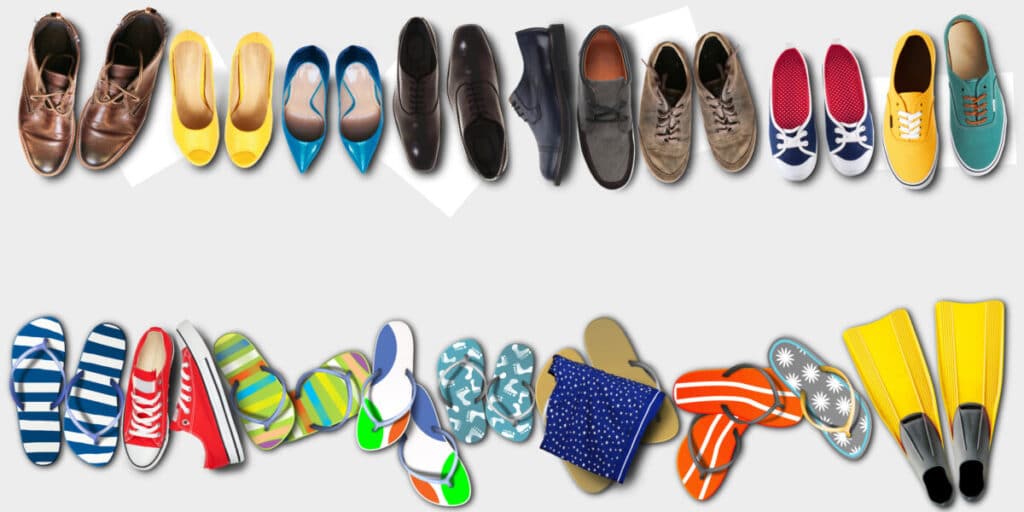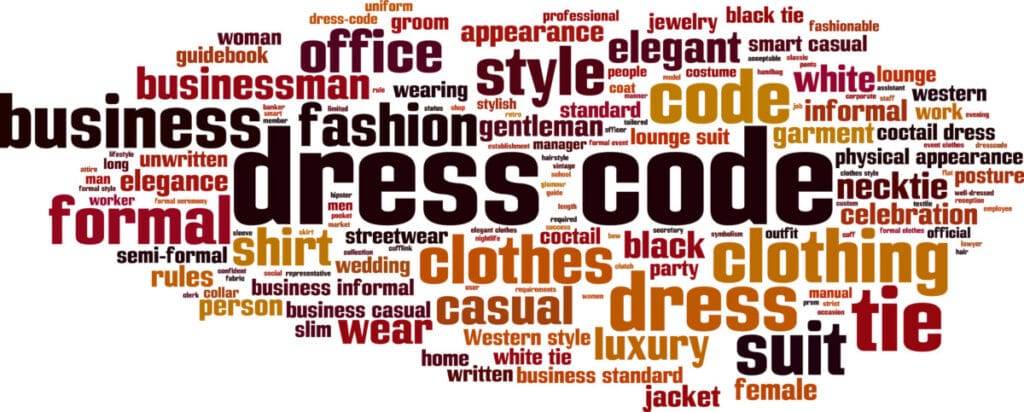Most Common Dress Codes for Public Schools in the USA
Every school has a dress code, including USA public schools. However, what are the most common rules included in the dress code of a USA public school?
Shirts
Many public schools don’t allow students to wear shirts that show their belly button or midriff, are strapless, off-the-shoulder, or are low-cut. Shirts that show a female student’s cleavage also aren’t allowed. Students also aren’t allowed to wear shirts that show an excessive amount of shoulder, have cut-outs, an excessive number of holes, or have a slit on the side.
American public schools often don’t allow their students to wear halter tops, although some schools that are located in areas with a warmer climate do allow them. However, they have to cover most of the student’s backs and can’t show their midriff, and it is hard to find a halter top that fits those requirements.
Shirts also can’t be made of mostly mesh without an undershirt (tank top or T-shirt), show a large amount of back, or show undergarment straps. If a shirt shows a student’s torso, including the sides of their torso, they will be asked to change or wear something over the shirt.
If a student is wearing a button-down shirt, they can’t wear the shirt with only a few buttons done up. Either all of the buttons have to be used, or none at all. If a student chooses not to button up their shirt, they must be wearing a tank top or another shirt underneath the button-up.
However, a student can wear T-shirts and blouses that have sleeves. But the T-shirts that a student wears can’t have any potentially offensive images, text, or graphics.
For example, your T-shirt can’t have text or images that suggest your political views, images or artist renderings of deities, logos or text linked to hate groups, references to tobacco or marijuana (and other drugs), guns, sexual innuendos, offensive gestures, or references to alcohol and its consumption.
Some schools don’t allow students to wear clothing or T-shirts that show support or hatred towards the LGBTQ+ community. (Source)
Students can’t wear jerseys while at school unless it is a school jersey or there is an exception for spirit week.
Tank Tops

Most American public schools have a “no shoulder” policy, so students often aren’t allowed to wear tank tops without a cardigan covering their shoulders. However, it is rarely enforced unless a female student’s bra straps are showing or the tank top’s straps are loose and will potentially fall off. Male students are not allowed to wear tank tops.
Tank tops with spaghetti straps are not allowed to be worn by students or faculty. If you wear a tank top, the strap has to be thick enough that two of your fingers fit inside of or on top of the fabric of the strap. If you put two fingers together and try to cover the strap and your fingers overlap the fabric and touch your shoulder, it is too thin of a strap. (Source)
Muscle shirts and strapless shirts are also not allowed to be worn by students and faculty at most American public schools.
Shorts
Most American public school dress codes allow students to wear shorts, but they can’t show anything inappropriate when students bend or sit down. If a student wears shorts to school, they can’t have a lot of holes in the front or back, and they have to pass the fingertip test.
The fingertip test is when a student lays their arms fat against their sides. If the hem of the shorts is at or below the student’s fingertips, they are long enough and can be worn at school. However, if the student’s fingertips reach below the hem of the shorts, they are too short to be worn at school, and the student must change their pants.
Some schools require shorts to be 2-3 inches below the student’s fingertips, but with recent fashion trends that rule has nearly died out, as it is almost impossible to find shorts that are that long.
Pants

A student that goes to an American public school can wear any pants they want to as long as they do not sag and do fit well at the waist, covers all undergarments when the student sits or bends down, don’t have large holes, and are not extremely tight.
Most public American schools don’t allow students to wear leggings unless they are also wearing a dress or skirt. That rule has changed slightly as leggings have become thicker and more popular, but many schools still prohibit them. Students can wear leggings under jeans if they have large holes in them, but students rarely do that nowadays.
Jeans that have large holes at the knee are sometimes allowed because they don’t show any undergarments or inappropriate skin. However, if there is a large hole in the pants on the student’s thigh, they will have to change or put something under the pants. Unfortunately, it has gotten harder to enforce this rule as ripped jeans are all the rage, and it is hard to find jeans without holes in them.
Skirts
Skirts worn by students that attend most American public schools can’t be extremely tight or form-fitting because of the school’s dress code. They have to be long enough that the student’s fingertips reach the hem or longer. This is the same rule that shorts have to follow. However, sometimes it is up to the teachers to determine if a student’s skirt is long enough to be appropriate. (Source)
If a skirt has a slit, it can’t reach above the middle of the student’s thigh. Since it is hard to find skirts that have extremely small slits that will fit the school dress code parameters, students should avoid wearing a skirt to school that has a slit.
Dresses
Dresses worn by female students can’t be off-the-shoulder, low cut, show off the student’s back or undergarments, or show their midriff. They also can’t be extremely tight or stop at the student’s mid-thigh.
The fingertip test is often done to ensure that the student’s dress is long enough. If the dress has a slit, it can’t go past the student’s mid-thigh. Luckily, oftentimes students don’t have to worry about these rules concerning dresses because they don’t often wear dresses to school.
Shoes

Although it is sometimes surprising to people, American public school dress codes have rules about the shoes that students wear to school. Students can’t wear a few types of sandals, flip-flops, or slippers.
Some schools prohibit all sandals, but most of the time if the sandals can stay on the student’s feet without issue, they can be worn at school when the weather is appropriate for them to wear said sandals.
Students can wear boots and high heels, but they can’t wear steel-toed boots or high heels that have an extremely high heel. Students can trip if the high heels are too high, and toes will definitely get stepped on. I don’t know if you have ever had your foot stepped on by someone wearing high heels, but it is extremely painful. (Source)
Steel-toed boots or shoes are not allowed to be worn by students at school because people can kick other students and seriously harm them. Although tap shoes can technically be prohibited, they are allowed when they are being used for a theater performance or practice. However, they can’t be worn in the halls of the school because the student will likely slip and fall. (Source)
Bandanas and Pajamas
Bandanas can’t be worn by any student because they can be associated with gangs and gang activity. If a student is allowed to wear a bandana, they aren’t allowed to wear the bandana on their head, neck, arms, or legs.
Students have to be in school-appropriate clothing while on an American public school campus, so they can’t wear pajamas at school. However, if there is a pajama day during spirit week, students can wear pajamas.
They just have to be school appropriate, so their pajamas can’t have large holes in them, be extremely thin, or be extremely low cut. Students also can’t wear a tank top and shorts as pajamas on school pajama day.
Jewelry
Students can pretty much wear any jewelry or accessories that they want to wear when attending an American public school, but their jewelry or accessories can’t be an indication that they are associated with a gang or hate group. Belts and belt buckles can’t be oversized, and the belts have to be done up. They can’t hang loose
The jewelry that students wear can’t be dangerous or distracting to other students. If a student is wearing multiple bracelets that make noise when the student moves their arm, they will likely be asked to take a few of them off, as the noise can distract other students from their schoolwork.
Students are allowed to have multiple piercings, but they are not supposed to have a tongue piercing because it is potentially dangerous. However, students who do have a tongue piercing can hide it easily, so it is extremely difficult to enforce that dress code policy.
Cleanliness
Something that is part of many American public school dress codes is cleanliness. Student and faculty clothing has to be clean and tidy. This means that if a student or faculty member works on cars in their free time, they can’t wear grease-stained shirts or jeans to school.
Although some stains on clothing are allowed, especially if the stains are not noticeable by faculty, large stains that are extremely noticeable, such as car grease and oil stains, are not allowed on clothing that is worn to school.
Students themselves have to be clean and tidy when attending class at an American public school because of dress code policies. They have to have recently showered and put on deodorant.
If a faculty or administration member notices that a student has not showered or put on deodorant recently, they will pull them aside and try to figure out why they are not doing what they are supposed to do. If there is an underlying issue like homelessness or lack of hot water at home, they will determine if they need to do anything to help the student get the proper hygiene.
Hats

American public school dress codes prohibit students from wearing hats or head coverings like scarves or bandanas while in the classroom. However, if you want to wear a baseball hat because you are self-conscious of a deformity or health condition that affects your hair or head, you can get an exception. My younger brother was allowed to wear a hat in class because of a medical condition that made his hair fall out, which he was self-conscious about.
However, most American public schools allow students to wear baseball hats while roaming the halls. They just have to take their hat off as they enter the classroom. Most people are not sure what the cause of this rule is, but it is assumed that students are not allowed to wear hats in the classroom because it can block the view of the students behind them.
Even while roaming the halls, students have to wear their baseball hats with the brim forward rather than backward.
Students can get an exception and are allowed to wear head coverings if they are wearing the head covering because of their religious beliefs. For example, students are allowed to wear the following:
- Hijab
- Niqab
- Burqa
- Yarmulke
- Tichel
- Dastar
If you wear a religion-related head covering, you will likely need to go to the school’s office to fill out an exemption form. However, most teachers and security guards will not ask you to take off your head covering if it is obviously religion-related.
If you go to an American public school and are not sure what your school’s dress code allows and prohibits, go to the school’s website and find the dress code. You may also be handed a booklet that contains the dress code on your first day of school.
Schools often send booklets containing school rules and the dress code to student homes before the school year starts so students can come to the first day of school prepared and wearing appropriate clothing.

